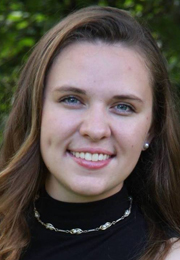SRU’s exercise intervention study changing inmates’ lives

Slippery Rock University student and faculty researchers are working on a group exercise intervention program with inmates at the Butler County Prison.
June 7, 2017
SLIPPERY ROCK, Pa. - Inmates at the Butler County Prison have been liberated thanks to the collaborative efforts of student and faculty researchers from Slippery Rock University. No, the SRU contingent are not accomplices to a prison break, but rather freeing the spirits of the inmates through a group exercise intervention program.
And some of the results are clearly visible.
One inmate, thumbing through a Men's Health magazine between workouts, is now eager to become a fitness instructor when he is released. A second inmate, partially paralyzed from several gunshot wounds, is not only walking better, but more noticeably, revealing a smile for the first time since being incarcerated.

SMITH
"I love to see change and I love to inspire people to change," said Kim Smith, associate professor of exercise and rehabilitative sciences. "Intervention research is what I do but never before with this population."
The anecdotal evidence is apparent to the research team, which includes students and faculty from criminology and security studies, psychology and exercise science, the latter of which are instructing hour-long workout sessions three times per week at the prison. However, what's learned from qualitative data will be determined after the second cohort completes the program later this month and data from a control group and recidivism rates can be analyzed.
Researching the effects of exercise among the incarcerated is not new, but the SRU research is unprecedented by its extent, both in duration (12 weeks per cohort) and type of instruction (regimented workouts as opposed to simply logging activity).
"It's really impacted the tension level," said Jeff Bailey, reentry coordinator at the Butler County Prison. "The inmates really like it and it's curbed a lot of behaviors. It's sparked interest beyond the original participants who signed up because word travels among the inmates. We had people asking us, 'Hey, can we get involved in the workouts?'"
Inmates who qualified, 66 across the two cohorts, also must enroll in the prison's reentry program or other treatment groups to participate. As a result, the exercise intervention provided a benefit that went even beyond the physical, social, emotional and physiological benefits of group exercise.
The idea for group exercise at the prison began last year when Bailey met with Sarah Kuehn, assistant professor of criminology and security studies, who had been working as a consultant for the prison's reentry program. At the time, inmates could exercise on their own in an enclosed room with a basketball hoop, pull-up bar and a roman chair. Recognizing the need for a more organized program, Bailey asked for a recommendation from Kuehn, who put him in touch with Smith.
From there, Smith sought out faculty and student research grants totaling nearly $5,500, not counting a pair of Summer Undergraduate Research Experience grants for exercise science and and criminology and security studies at $725 each. The money helps pay a small hourly wage for the student instructors and equipment, such as prison-approved equipment, including resistance bands, mats and stability balls.

KELTZLI
Two of the program's more deeply involved student researchers are Sarah Hess, a junior psychology major from Erie, and Kate Kletzli, a senior exercise science major from Butler. Hess is collecting and analyzing survey data from the inmates and conducting a literature review, while Kletzli is the coordinator of the 15 exercise science majors who act as instructors.
Besides having taken Exercise Leadership: Aerobic Fitness, a 300-level course, the student instructors had minimal experience as group fitness coaches. However, they entered the prison as if they were seasoned professionals.
"They are great," said Bailey, who was particularly impressed by how the students learned all the inmates' names, and vice versa. "The students who came in have been very interactive and motivating and it's very apparent that Dr. Smith teaches them well because you would almost never know that they are actually students. It's not an easy thing to impress that population."
When the student instructors arrive at the prison for workouts, they pass through all the security checks before being issued a visitor's badge and an alert device. There are always at least two corrections officers present. While the students cannot have physical contact with the inmates, they are about an arm's length away from.
"I was very surprised when I went in the first time," said Kletzli, who was there for the initial workout in February. "I was not nervous, I didn't feel unsafe and I wasn't intimidated to the point I thought I would be. (The inmates) were really receptive, they listened and they were appreciative of every session."
Kletzli added that she is more intimidated by instructing a group in a private gym or on campus because the participants in those groups can be more knowledgeable, and thus more judgmental.
"The students have been so inspiring," Smith said. "It's been awesome to watch them grow as instructors, as human beings, and how they are compassionate, non-judgmental and brave. Everyone was like, 'Oh, prison, that's hardcore,' but they've loved every second of it. They gave me a big hug and thanked me for opportunity."
The group exercise program has brought people together in a positive fashion and in more ways than one. For the first time at Butler County Prison, inmates are participating in an activity with mixed populations from other housing units, or "pods," where they are assigned based on classification.
"All of them getting along, having fun and really, really working out hard," Bailey said. "It's actually been a huge success."
"The other really nice thing is what it means to the students," Kuehn said. "It's a population they usually don't work with, especially if you're not a criminology student. That is very empowering."
While the experience may be deemed a success, how the research team will be able to use the data remains to be seen. After analyzing the data, they will present their findings at campus, regional and national conferences which could include SRU's Symposium for Student Research, Scholarship and Creative Achievement; the Pennsylvania Association for Criminal Justice Educators; the American Society of Criminology; and the American College of Sports Medicine. They will also attempt to get their work published as collaborative research articles in peer-reviewed journals.
"The biggest challenge is that it's longitudinal," Kuehn said, acknowledging the reason no one has done a 12-week study of inmates before: the prison setting can greatly diminish the retention rate of participants. "We're going to see what we can actually do with the data because of all the issues."
Of the 66 inmates who qualified and entered the study, only about one third completed the full 12 weeks due to early release, transfers or work release; entry into rehabilitation treatment; or removal due to behavioral reasons.
"We have a ton of questions," said Smith, who entertained the thought of the research project spurring a state or federally funded exercise program to better prepare inmates' reentry into society and potentially limiting the likelihood that they will return to prison. "We know that exercise can change you physiologically. We know it can change you psychologically. What we don't know is what happens with the incarcerated population because there's never been a study long enough to see any of these changes."
Kletzli also recognizes the challenges, but is encouraged by what she's learned and the impact she's made on the lives of the inmates.
"Even with those who aren't able to complete the whole program, I believe we are able to make some difference to them during the time we spent with them," she said. "If you look at it very objectively and say, 'This is how many you started with and this is how many you are getting results from, this is how many have dropped out,' it's very different than if you look at it like, 'Well, this is what we're changing and how we're using exercise to better themselves.'"
Kletzli related her experience to the parable of the starfish thrower, where a boy is on a beach with thousands of washed up starfish and he throws one back into the water. The group exercise intervention at Butler County Prison may not be able to save all the inmates, but after Kletzli read an inmate's questionnaire which included a comment about how the exercise intervention changed his life, she recites the starfish thrower's rebuttal: "I made a difference for that one."
MEDIA CONTACT: Justin Zackal | 724.738.4854 | justin.zackal@sru.edu

